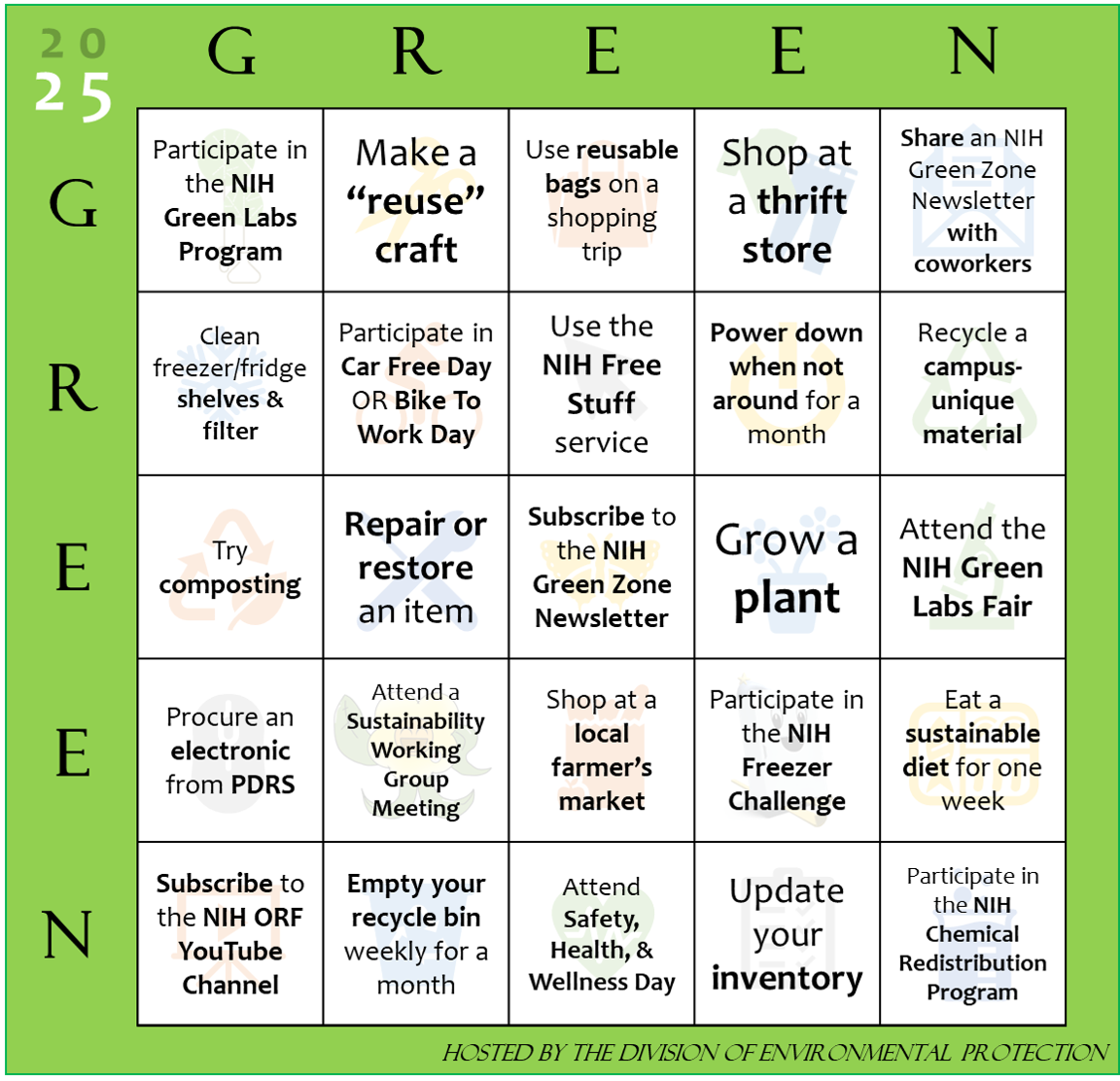
SUBSCRIBE PREVIOUS ISSUES
Take Action
2025 GREEN Bingo Board
If you weren't able to get a bingo last year, then get ready for round two of the GREEN Bingo Board! Commit yourself to reducing resource use and improving the environment by trying these 25 initiatives throughout the year. See if you can tick off more boxes than your colleagues!
The Green Bingo Board is a tiled, 5x5 table, where each tile encourages you to complete or promote green activities. Certain activities can be completed both at work and at home. Unless noted otherwise, all activities must be completed between January 1 and December 31 of 2025 to count.
This year, we have made the bingo board a downloadable form, so you can mark off completed initiatives with a single click. Send us your board by December 1. We will review the submissions and the person with the most tiles will get their own Spotlight article! Good luck!
More information on the activities is detailed below:
ROW G
- Column G: The NIH Green Labs Program is an annual self-assessment program which is scheduled to reopen in early Winter. Many of the initiatives in the assessment are also on this board!
- Column R: Reuse does not have to be boring. Try making crafts from items that would otherwise be trash, such as quilts from old cloth or planters from soda jugs.
- Column E1: Single-use plastics present problems with pollution and per- and polyfluoroalkyl substances (PFAS) exposure. Avoid this by using a reusable bag on your next shopping trip.
- Column E2: Producing new clothes, especially jeans, uses a lot of resources. Thrifting offers new fashion options without the impact.
- Column N: An easy way to contribute to green efforts is to share information with others. Share these articles with a coworker to help them stay informed!
ROW R
- Column G: Cleaning out cold storage units helps with inventory management, and cleaning the filter improves compressor reliability. Both lab equipment and home fridges count for this one!
- Column R: Transportation consumes resources while producing air pollution and greenhouse gas emissions. Participate in Car Free Day (Sep 22) and/or Bike to Work Day (May 15) to offset this.
- Column E1: NIH Free Stuff is a site where NIH employees can exchange supplies and equipment. Before you buy (or discard), try this site.
- Column E2: It's important to unplug and turn off appliances, lights and machines when you leave for the day. Do so for an entire month to reduce energy waste!
- Column N: Certain NIH campuses offer recycling programs for special materials not often recycled. Check this site to see what unique opportunities are at your campus.
ROW E1
- Column G: Composting is a great way to repurpose food scraps and old organic material. See if your local municipality hosts a program or attempt your own at home.
- Column R: Sometimes, all an item needs is a good patch-up. Fix, sew, or in any other way, restore an item to reduce waste and emissions and save some money as well!
- Column E1: This one counts if you have already signed up, regardless of when. If you haven't, why not sign up now and check off a tile today?
- Column E2: Plants are very versatile in their benefits. In addition to producing oxygen, they provide home cooling,1 improve water quality,2 produce food3 and much more.4
- Column N: The Green Labs Fair is scheduled for early Fall 2025. Visit the fair to see green vendors and organizations interested in sustainable and efficient laboratories.
ROW E2
- Column G: The OLAO Division of Logistics Services manages excess property through the Property Reutilization and Disposal Section (PRDS) Warehouse. Claim a used item from the warehouse instead of buying a new one!
- Column R: It's likely your ICO has a Green Team that meets multiple times to discuss sustainable topics and options. For those without a Green Team, contact green@od.nih.gov to join the Green Team Leads Council or Sustainable Lab Practices Working Group.
- Column E1: It takes a lot of fuel and packaging to transport food around the world. Buy groceries from a local farmer's market to reduce that travel distance and support local business.
- Column E2: The Freezer Challenge helps further improve your lab freezers' reliability and reduces energy consumption, operating costs, and emissions. If you couldn't participate earlier this year, simply sign up here to get this initiative.
- Column N: Choosing local foods and favoring fresh ingredients over processed ones are some of the cores of a sustainable diet. Read more, explore ideas and try it for a week!
ROW N
- Column G: This one counts if you have already signed up, regardless of when. The NIH ORF YouTube Channel has all sorts of interesting videos on greening topics. Subscribe to stay up to date on the newest uploads.
- Column R: Don't let that recycling bin get too full! Set a reminder to help and empty it each week for a month.
- Column E1: Safety Health & Wellness Day is scheduled for June 10 this year. Attend to learn about different programs and groups established for your wellness.
- Column E2: Sometimes, you already have what you need! Whether cold storage or chemical storage, ensuring inventory accuracy will help reduce unnecessary costs and waste.
- Column N: The Chemical Redistribution Program ensures that chemicals end up in the right place. If you have too much or not enough of a chemical, try this free program.

Featured Article

|
Towards a Nuclear Future
Nuclear energy is the highest-potential energy source available today. Nuclear power plants inspire feelings of awe, fear, promise and peril. The ever-growing need for reliable, clean and efficient energy is driving a shift in attitudes which the Administration is responding to.
LEARN MORE
|
Spotlight

| Discovery Lake Dam Repair
Discovery Lake Dam was constructed in the Research Triangle Park (RTP) campus in 1977 to control flooding. As time went on, the internal drainpipes deteriorated and required repair. Bill Steinmetz, NIEHS Environmental Compliance Officer, provided some interesting insights into the project.
LEARN MORE
|
Fun Fact
Did you know? At Research Triangle Park, the name “Discovery Lake" was chosen from over 500 entries submitted by employees in a lake naming contest during the summer of 2012. The lake had previously been called NIEHS Lake, Drew Lake, Noname Lake, and unnamed tributary to Burdens Creek.
Newsletter Feedback If you found this article useful, please let us know! We appreciate hearing how we might improve our future articles, including topics you would like to read about. Please take a moment to complete this quick feedback form:
The NIH Green Zone Newsletter is a publication intended to inform NIH staff about the Division of Environmental Protection and NIH Green Teams projects and initiatives. The text contained in this newsletter is not copyrighted and can be reprinted without permission. If you use portions of this newsletter in your own publication, we ask that you please credit the source. We welcome your comments and suggestions. Thank you.
|
|---|
|
Division of Environmental Protection | Office of Research Facilities | Office of Management
National Institutes of Health | U.S. Department of Health and Human Services
|